Cotton plants take over 200 days to mature, starting their growth from December to March in warm temperatures. When harvested in autumn, they need lots of water and sunlight. Bolls burst open to show fluffy white fibers, signaling they're ready for harvest. This makes gathering cotton easier after separating the seeds. Plus, cotton plants with salt-tolerant seeds can thrive in coastal areas and even salty spots. These three facts offer just a glimpse into the fascinating world of cotton's growth, harvest, and adaptability. More secrets await in its journey from seed to fabric.
Table of Contents
Key Takeaways
- Cotton bolls burst to reveal valuable white fibers.
- Salt-tolerant cotton seeds enhance adaptability and resilience.
- Fluffy white fibers are crucial for textiles.
- Growth period of cotton plants is over 200 days.
- Cotton plants thrive in temperatures above 25 degrees Celsius.
Growth Period of Cotton Plants
During the growth period of cotton plants, they typically require over 200 days to reach maturity. This growth phase usually commences from December to March, aligning with high temperatures above 25 degrees Celsius, which are ideal for best growth.
The cotton plants are harvested in autumn when they've fully matured, indicating the end of their growth cycle. Adequate water supply is essential during this growth period to make sure the cotton plants have the necessary resources to thrive.
Ideal conditions such as proper irrigation and sunlight exposure play an important role in nurturing cotton plants during this critical stage of development. Understanding the specific needs of cotton plants during their growth period is necessary for farmers to cultivate a successful crop.
Bursting of Cotton Bolls
When cotton bolls reach maturity, they burst open to reveal the valuable fibers inside, signaling the readiness for harvesting. This critical process is a natural occurrence that's essential for separating the fibers from the seeds.
As the cotton bolls burst, the fluffy white fibers are exposed, ready to be collected for various uses. Harvesting can commence once the bolls burst, allowing farmers to gather the cotton efficiently.
The bursting of cotton bolls is a significant stage in the cotton production process as it enables the extraction of the sought-after fibers. Through this natural process, the seeds are also separated, making it easier to refine the cotton fibers for quality textiles.
Witnessing the bursting of cotton bolls isn't only a visual indicator of ripeness but also a practical step towards obtaining the raw material needed for a range of cotton products.
Salt-Tolerant Cotton Seeds
How do salt-tolerant cotton seeds contribute to the adaptability of cotton plants in various environments?
Salt-tolerant cotton seeds play an important role in the resilience and adaptability of cotton plants, allowing wild cotton species to thrive in saltwater areas.
These seeds enable the global spread of cotton plants, especially in coastal regions and islands, where saline conditions prevail.
The ability of cotton seeds to withstand saltwater environments enhances the cultivation of cotton in diverse settings, expanding its reach and ensuring its survival in challenging habitats.
The salt tolerance of cotton seeds is a key factor in the success of wild cotton plants, as it provides them with the necessary protection against high salinity levels.
Frequently Asked Questions
What Are 3 Things Cotton Is Used For?
Cotton is versatile. It's in my clothes, bedding, and towels. The fabric's softness, durability, and breathability make it top choice. I also appreciate cottonseed oil's use in cooking and other products.
What Are Some Facts About Cotton for Kids?
Cotton, a plant grown for ages, pops open bolls to reveal soft fibers. Its seeds turn into cooking oil. From clothing to home decor, cotton thrives in various industries. Understanding its growth can foster appreciation.
What Is Special About Cotton?
Cotton, a versatile natural fabric, stands out for its softness, durability, and breathability. Its fibers are spun into yarn for various products. Its long history and widespread use make it a staple in clothing, home goods, and industry.
What Are Some Fun Facts About Cotton Seeds?
Cotton seeds, often overlooked, hold surprising versatility. They're not just seeds; they're also classified as fruits! While tasty cottonseed oil is a common product, remember, raw cotton seeds are a no-go due to toxic compounds.
- How Does Ring Spun Cotton Affect Garment Fit and Shape Retention? - August 13, 2024
- What Are the Challenges in Producing Ring Spun Cotton? - August 13, 2024
- Is Ring Spun Cotton Suitable for Plus-Size Clothing? - August 13, 2024




